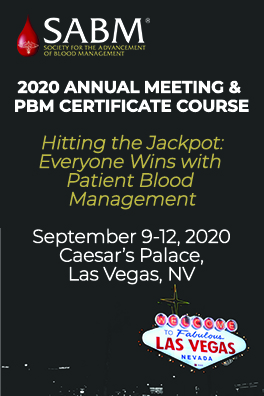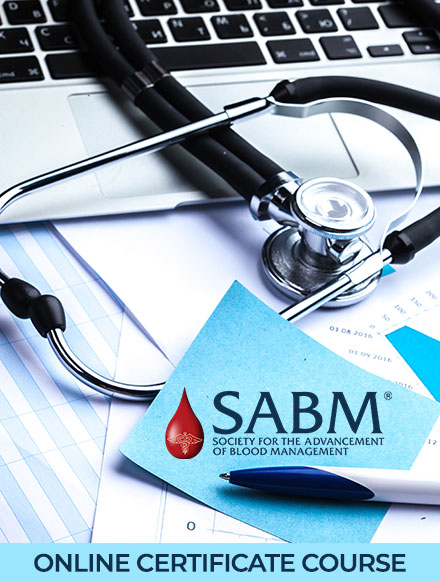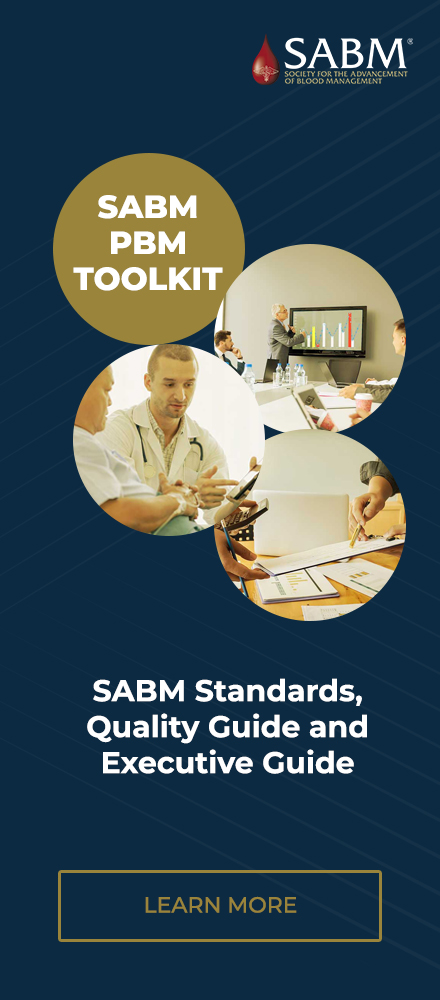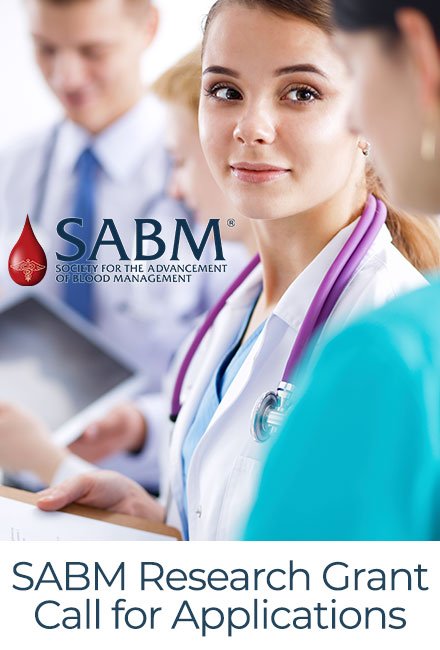DECEMBER 2019
ISSUE

Please consider making a donation to your Society. Your donations will help us to improve the lives of people throughout the world through Patient Blood Management.
SABM 2019 Newsletter Publication
Editor: Kevin T. Wright
Associate Editor: Majed Refaai, MD
Christine Cahill, MS, BSN, RN
Mary Ann O'Brien, RN, MSN, CCRN, CNE
Contributors for This Issue
Eloa Adams, MD
Leon Binette, RN
Carolyn Burns, MD
Tiffany Hall, RN
Queeneth Kalu, MD
Sherri Ozawa, RN
Prakash Patel, MD
Becky Rock, RN
Stephanie Smith, RN
Nathaniel Usoro, MD
Sarah Walbolt, BSN, RN
Marketing
Carmen Melseth
SABM Officers and
Directors
© 2019 Society for the Advancement of Blood Management
350 Engle Street Englewood, NJ 07631 USA Phone: (928) 551-6400 Fax: (877) 944-2272 EMAIL: [email protected] |
News & Events
Co-Chairs of the 2019 Annual Meeting Planning Committee
SABM’s 18th Annual Meeting has now come to an end, and as Co-Chairs of the 2019 Annual Meeting Planning Committee, we want to thank all those who contributed to making it a great success. This year’s meeting included 112 participants in the PBM Certificate Course and 433 attendees for the meeting. Along with the city of Baltimore, we also want to thank our hospital sponsors at Johns Hopkins Medicine Center for Bloodless Medicine and Surgery; Medstar Health Institute for Quality and Safety; The University of Maryland School of Medicine Departments of Anesthesiology and Pathology, the University of Maryland Medical Center, the R Adams Cowley Shock Trauma Center, and the Marlene and Stewart Greenebaum Comprehensive Cancer Center. We would like to extend our thanks to the speakers and our planning committee for contributing to the program and for sharing their expertise on the latest in evidence-based PBM.
This year’s SABM meeting centered around the concepts of patient safety and quality care as they relate to PBM. Along with sessions dedicated to the meeting theme, we were also fortunate to hear from Dr. David Mayer, an international expert in patient safety, as our Keynote Speaker. This year we also continue to expand our relationship with NATA as we work on creating a global definition for PBM. Furthermore, SABM collaborated with the American Society of Anesthesiologists to hold a joint session on our common interests. With continued partnerships such as these, as well as a growing focus on the value PBM brings to health care, this year’s meeting further supported SABM’s work to increase the exposure of PBM to a broader audience, while strengthening its position as the leader in the field. Thank you again for your support, and we look forward to seeing everyone next year!
Sherri Ozawa, RN
Prakash Patel, MD
Safe Patient Discharge: How PBM in Acute Care Targets Quality and Readmission
SABM 2019, held in Baltimore MD, had a central theme of patient safety and quality. It was a privilege then to present what has been accomplished at my institution, highlighting the key aspects contributing to the success and growth of PBM at ProMedica Health System in Toledo, OH. Our PBM department has a mission of “Protect. Optimize. Advocate”. In the acute care setting, we accomplish this through physician consults, patient rounding, education, and transitional planning for discharge.
Maximizing functionality of electronic medical records (EMR) has aided with ease of consulting, organizing consistent workflows, and multidisciplinary communication. Knowing each patient's risk for re-admission is a crucial detail. Patients with high risk of readmission at ProMedica receive a multidisciplinary care plan with interventions such as: multidisciplinary rounding, ensuring medications can be obtained, follow-up appointments made prior to discharge, and a follow-up phone call within 48 hours. EMR documentation on the discharge summary helps the patient and primary care physician understand who is responsible to follow the patient post-discharge. For example, if patients discharge from acute care prior to completion of iron therapy as part of anemia management, they may continue therapy through the ambulatory anemia program.
Participation in quality improvement projects helps to bring awareness and improved practices to organizations. In 2018, the PBM department at ProMedica participated in a quality improvement project targeting pre-optimization for cardiothoracic surgical patients. Workflows were created between the surgical office staff, physicians, and the blood management team. The eight-month project led to a positive financial impact of some $193,000.00 for the hospital organization. We are continuing to improve processes, including insurance reimbursement challenges.
SABM has played a critical role in the development of PBM at ProMedica. If tasked with building or growing a PBM program, build the framework of your department based on the solid foundational evidence that SABM provides. Realize that every organization is different, and it will take innovative leaders who thrive on engineering and designing a program to meet the needs of the organization. Use the Toolkit, Standards, Quality and Executive Guides to assist with program development. Lastly, do not forget to mentor others and to be mentored as we all strive for excellence and best practice.
Contributor: Sarah Walbolt, BSN, RN
The Challenge of Treating Jehovah's Witness Patients
For the medical community, treating Jehovah’s Witnesses has presented both a challenge and opportunity in the use of blood management strategies. The Witness’s refusal of blood transfusion has been continually debated among clinicians. However, understanding a patient’s personal beliefs regarding treatment is essential to their health and wellness.
The presenter Rita Schwab, CPMSM addressed the question of why Jehovah’s Witnesses refuse blood transfusions. They cite biblical direction, for example Acts 15:29 which says in part to “keep abstaining…from blood.” (NWT Study Bible) Although such beliefs may differ from the personal belief of the clinician, recognizing its importance to the patient promotes respect for self-determination.
The question of treatments or procedures that Witnesses accept was also addressed; simply stated: they accept medical and surgical procedures without the use of allogeneic blood. Witnesses want the best medical care possible while respecting their beliefs. Some of the alternatives to blood transfusion include: clotting factors, immunoglobulins, growth factors such as erythropoietin. Intraoperative techniques may include hemodilution, intraoperative blood salvage and pharmaceuticals. The presenter noted that the decision to accept certain blood fractions and/or procedures is a personal decision for each Witness. This need not present a challenge for the clinician, but instead provides an opportunity for interdisciplinary collaboration and increased knowledge.
There are several resources available to assist both Witness patients and treating clinicians. For example, Witnesses are encouraged to complete a Durable Power of Attorney (DPA) which provides a clear statement of treatments and procedures that are acceptable, including health care agents who are aware of the patient’s wishes in the event of incapacitation. Furthermore, a unique 24/7 resource known as the Hospital Liaison Committee (HLC) is available. This group of specially trained community based ministers provide information regarding alternatives to blood transfusions. The HLC is even available in emergency situations. A very helpful resource can be found on the jw.org website which has a section entitled: Medical Information for Clinicians. This section contains a surprising amount of authoritative medical journal citations.
The responsible transition of healthcare for non-blood medical management segues to PBM programs. The well formed PBM program offers a multidisciplinary, highly skilled healthcare team. This affords Jehovah’s Witnesses a variety of clinicians who are willing to provide medical and surgical care that consistently leads to favorable patient outcomes.
Contributor: Stephanie Smith, RN
Current Developments in Hemoglobin-Based Oxygen Carriers
In the beginning...
The search for artificial blood, now named artificial oxygen carriers (AOCs) is virtually as old as the history of modern blood transfusion. Early efforts in 1916 by Dr. Tunnicliffe using saline to infuse oxygen, to recent innovations with AOC, have seen a journey full of excitement, but also much disappointment and some confusion. In this 30-minute talk, Dr. Shander, inarguably an expert on the subject, brought some clarity as he took a global look at AOCs and hemoglobin-based oxygen carriers (HBOCs), their challenges and current developments.
“Another Step Closer to Artificial Blood”
Historically AOCs were either HBOCs or perfluorocarbons. Now AOCs include nanoscale artificial RBCs, currently in the experimental stage. HBOCs are traditionally made from either expired human or bovine hemoglobin. Dr Shander highlighted a new product made from purified human hemoglobin proteins coated with a synthetic polymer. The product is stored as a powder and reconstituted with sterile water for infusion, with better safety profile and efficacy expected. “Another Step Closer to Artificial Blood” is how an article by Dennis Thompson in 2016 described this new experimental HBOC.
“All HBOCs Are Not Created Equally”
Different HBOCs have different structures which affect their function differently, a subject explored in a recent paper by Meng et al (2018). Their conclusion was that “one can therefore select independently between these diverse properties to engineer a safe and effective HBOC with improved biochemical/biophysical characteristics.”
Expanding potential indications for HBOCs
Beyond patients who decline blood transfusion, Dr Shander pointed out that Njoku et al (2015) outlined several other situations where HBOCs could be beneficial, including sickle cell disease, preservation and resuscitation of organs before transplant, and where donor blood is contaminated or may produce adverse events. Weiskopf et al in 2016 suggested “addressing the unmet need of life-threatening anemia with hemoglobin-based oxygen carriers.” Hidenobu et al in 2017 described the use of HBOC in pre-eclampsia.
Light at the end of the tunnel?
The search for better AOCs and HBOCs continues – including trials of “Lugworm blood”! At present HBOC201 is the only agent that is licensed for use, only in South Africa. Dr Shander made a case for not comparing AOCs with RBCs or insisting on equivalence before licensing, and suggested possible approval as “orphan drug” in view of the challenges with conducting significant trials. Yes, there seems to be light at the end of the tunnel!
Contributors: Nathaniel Usoro, MD; Queeneth Kalu, MD
View Bibliography
Oxsealife® Research Project

Lara Oller, MD, an anesthesiologist in Spain is leading the Oxsealife® research project which is an innovative approach to hemorrhagic shock treatment. This enhanced IV fluid product has a higher coefficient of solubility for oxygen and components to generate nitric oxide at the capillary level and attenuate injury after reperfusion. A pilot study has been performed and the first paper was recently published in Anaesthesia. Experimental trials are underway in Australia with the potential for improved survival rates beyond typical blood restoration.
|




Consider submitting your future manuscripts in PBM for peer review and publication in this new section. The success of this endeavor will depend on the provision of material to make it lively and attractive to our colleagues and other professionals in the field.
Members Invited to Submit Papers CLICK HERE
|